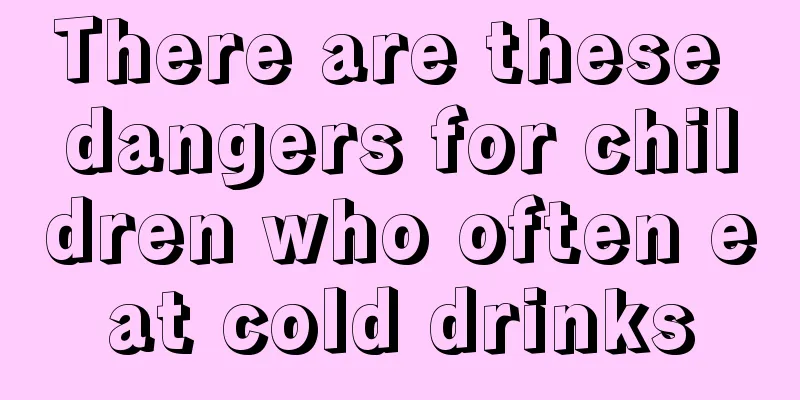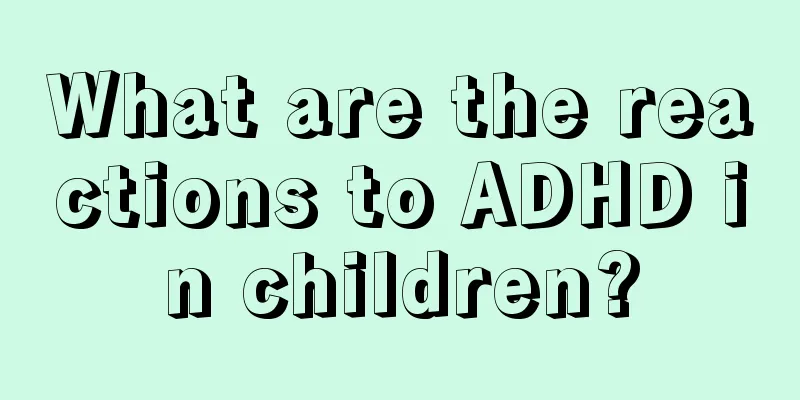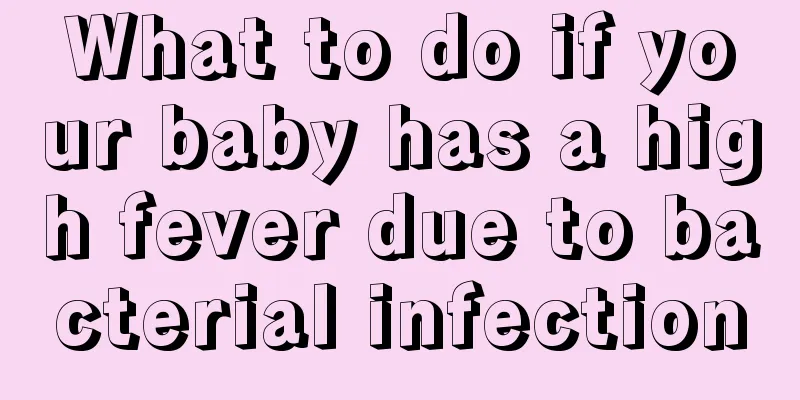There are these dangers for children who often eat cold drinks

|
As the weather gradually gets warmer, a lot of cold drinks come with it. Many children prefer cold drinks, and the cool feeling is particularly comfortable. However, it is very bad for children to often eat cold drinks. Things that are too cold will stimulate the stomach and intestines, causing abdominal pain, diarrhea and other symptoms. Eating cold drinks frequently will lead to gastrointestinal diseases such as indigestion, and it is also very bad for teeth. Taboo group As the weather gets warmer, sales of cold drinks are booming. Relevant experts remind that cold drinks should be consumed in moderation after the summer, and some patients should pay attention to dietary taboos, otherwise it will affect their health. Specifically, the following groups of people should pay special attention when consuming cold drinks: 1. The elderly and young children. Because this group of people have a weak constitution, if they eat a lot of cold drinks in a short period of time, they may experience oral muscle paralysis and spasm. The sudden cooling of the gastrointestinal tract stimulates the intestinal mucosa and causes irregular gastrointestinal contractions, which may cause abdominal pain. Due to uneven cold and heat, the normal contraction and relaxation of gastrointestinal blood vessels are adversely affected, leading to gastrointestinal dysfunction, accelerated intestinal motility, and easy occurrence of diarrhea and other symptoms. 2. Diabetic patients. Cold drinks generally contain more sugar, which can increase blood sugar levels in patients and worsen their condition. 3. Patients with duodenal ulcer, chronic gastritis, chronic colitis, cholecystitis, and indigestion. 4. These patients have poor digestive system function, and eating cold drinks can easily irritate the gastrointestinal mucosa and aggravate the condition. 5. Patients with caries and tooth hypersensitivity. For this type of patients, eating cold drinks can induce toothache. 6. Patients with hypertension, coronary heart disease and arteriosclerosis. If this type of patient consumes a large amount of cold drinks, it will suddenly stimulate the gastrointestinal tract, causing blood vessels to constrict and rise, aggravating the condition and easily inducing cerebral hemorrhage. 7. Patients with pharyngitis, bronchitis, bronchial asthma and arthritis. Under the stimulation of cold drinks, these people may experience worsening throat inflammation or induce coughing, or cause a recurrence of old illness. 8. Patients with kidney disease. This type of patients should not consume cold drinks containing flavors, pigments, spices and other ingredients, because these ingredients will increase the burden of glomerular filtration and detoxification, and at the same time may make the edema symptoms more severe. 9. Obese patients. Cold drinks contain a lot of sugar, which will increase glycogen in the liver and convert it into fat, making the body fatter and easily inducing fatty liver and hyperlipoproteinemia. Precautions cold drink 1. Avoid excessive drinking. Excessive consumption of cold drinks can cause stomach bloating and discomfort at the mildest, or indigestion, gastroenteritis, diarrhea, etc. at the worst. 2. The types should not be too diverse. Drinking too many kinds of cold drinks and mixing them with each other is harmful to your body. Children should be especially careful to drink cold drinks in moderation in summer. 3. Avoid drinking excessively after sweating. Drinking excessively after sweating profusely will stimulate the contraction of blood vessels and skin, causing "stop sweating". Not only will it fail to replenish and regulate the body's water and salt quickly, but it will dilute the gastric juice, thereby leading to gastrointestinal diseases. 4. Patients with chronic diseases should not drink excessively. Patients with chronic bronchitis, asthma, and coronary heart disease should not drink excessively. At the same time, be careful to choose varieties with moderate sweetness and drink them in moderation to avoid inducing illness. 5. Do not drink excessively on an empty stomach. Drinking all kinds of frozen foods on an empty stomach can easily stimulate gastrointestinal contracture, which will lead to various enzymatic chemical reaction disorders over time and induce gastrointestinal discomfort and other diseases. Impact on health The weather is hot and cold drinks begin to take over people's lives. But not everyone is suitable for cold drinks, especially some patients with chronic diseases, who should be more selective when drinking cold drinks, or even avoid them. Patients with gastric ulcer, gastritis, and indigestion should not eat too much cold drinks. Because patients have poor digestive system function, eating cold drinks can easily irritate the digestive tract mucosa, affect digestive function, and aggravate the condition. You should not drink cold drinks immediately after a meal. After a meal, most of the human body's blood is concentrated in the stomach and other digestive organs. If you drink cold drinks immediately after a meal, the dilated blood vessels in the stomach will contract, reducing blood flow and hindering the normal digestion process. The stimulation of cold water also speeds up gastrointestinal motility, affecting the body's absorption of nutrients. At the same time, cold water will dilute gastric juice and affect digestion. In addition, the elderly generally have reduced upper gastrointestinal function and their tolerance to cold drinks is also reduced. They should not drink a lot of cold drinks to avoid causing digestive dysfunction. It is best to drink water two hours before meals. Warm tea is an ideal drink. The best drink temperature is between 30-32 degrees Celsius, which is close to body temperature. The temperature of cold drinks is generally lower than the temperature inside the stomach. Drinking excessive amounts of cold drinks for a long time will cause the blood vessels under the gastric mucosa to contract, resulting in a decrease in the stomach's defense ability and affecting health. Drink less cold drinks and ice water, especially before or after meals, so as not to affect your health. Other related History of Cold Drinks Eating cold drinks has a very long history in our country. As early as more than 3,000 years ago, my country began to make ice using the most primitive method. For example, the Book of Songs recorded that slaves chiseled ice in winter and stored it for the nobles to enjoy in summer. In the Zhou Dynasty, officials who were specifically responsible for obtaining and using ice appeared, and they were called "Lingren". "Lingren" in "The Book of Zhou: Heavenly Palace" records: "Lingren is in charge of ice. In the twelfth month of the first year, he is ordered to cut the ice and cut it into three pieces." By the end of the Spring and Autumn Period, "iced rice wine" had begun to appear at the banquets of princes. By the middle of the Warring States Period, my country's cold drink production had reached a considerable level, and the custom of storing ice became even more popular during the Three Kingdoms period. There is a line in Qu Yuan's "Chu Ci: Zhao Hun" that says "The beautiful wine is already served, there is some fine wine", and later on it mentions "Zhejiang and Yaojiang". Zhejiang is the juice squeezed from sugarcane; Yaojiang refers to a paste-like cold food made from various fresh fruits. This nectar can be said to be the original product of modern cheese, ice cream, almond milk and loquat milk. Artificial ice was created in the Tang Dynasty. Su E said in "Duyang Miscellaneous Records", a notebook that records the ten dynasties from Baoying to Dazhong in the Tang Dynasty, that is, from Daizong to Yizong: "In midsummer, a wok is set up, and water is boiled in a crystal palm-sized piece. The soup is then filled into a Yue bottle, which is sealed with oil and silk. It is boiled again for a thousand times and then quickly sinks to the bottom of the ravine. It freezes flat and is called cold banquet ice." In the late Tang Dynasty, merchants added sugar to ice to attract more customers in order to drum up business. In the early years of the Song Dynasty, cold drinks had begun to enter the market in large quantities. People mixed fruit juice, milk, medicinal tea, ice cubes, etc. into frozen drinks called "bingru", such as the "Sugar Ice and Snow Lengyuanzi" from Bianjing in the Northern Song Dynasty, the "Snow Bubble Bean Water" and "Snow Bubble Plum Blossom Wine" from Lin'an in the Southern Song Dynasty. Yang Wanli, a poet in the Southern Song Dynasty, praised "ice yogurt" and wrote a poem for it: "It seems greasy but is also refreshing, it has just solidified but is about to float; it breaks into pieces at the bottom of the plate and melts like snow at the mouth." At this time, cold drinks not only had a wide variety of varieties, but also shed their aristocratic appearance. The users had expanded from court officials and nobles to ordinary people. Merchants during the Yuan Dynasty added honey and pearl powder to the ice. Ice cream began to be produced during the reign of Kublai Khan of the Yuan Dynasty. In order to keep the production process secret, he also issued an edict prohibiting the production of ice cream except for the royal family. It was not until the 13th century that the Italian traveler Marco Polo left China and brought the Chinese ice cream making method to Italy, and later spread to France and Britain. Marco Polo said in his book "Travels in the East": "In the golden country of the East, residents like to eat milk ice." Later, British businessmen changed ice cream into popsicles. In 1768, the Dutch chemist Priest created a kind of "Dutch water" that can quench thirst and relieve heat, which is now known as soda. In 1920, an American businessman successfully developed popsicles. From then on, popsicles became a favorite summer treat for people all over the world. During the Ming and Qing dynasties, there were more varieties of cold drinks, the most famous of which was Beijing's "iced sour plum soup". According to historical records, ice sellers in the north at that time often used copper cups to clink together to attract customers. For this reason, Wang Huanyang, a poet in the Qing Dynasty, once wrote a poem in praise of it: "The cherries have passed and the fragrance of tea has diminished, the sound of copper bowls is calling the ice seller." This shows that cold drinks were already quite common at that time. my country began to use machines to manufacture cold drinks as early as 1927. At that time, most of the popsicles sold in Shanghai were cylindrical, and the daily output was only two to three thousand. Later, the shape of the popsicle was changed to a long and flat shape. Nowadays, there are so many varieties of cold drinks that it is impossible to describe them in words. |
<<: What are the causes of constipation in children?
>>: Does the child have worms in the anus? What are the symptoms of worms?
Recommend
Is it normal for a newborn to drool?
After birth, babies will generally drool more or ...
Baby vaccinations
Everyone knows that the body resistance of a newb...
How to relieve stomach pain in children
In daily life, children may also experience vario...
What should I do if my child grinds his teeth at night?
If we often hear rustling sounds after falling as...
Treatment for blushing in children
Children's blushing often makes our parents a...
How to cultivate children to be brave
We all know that children nowadays are generally ...
Is it good to bathe a newborn baby every day?
In fact, most mothers know that it is not good to...
Children of close relatives
The main reason for close relatives to get marrie...
What should I do if my newborn baby always sticks out his tongue?
Children love to stick out their tongues. I belie...
How to make your baby talk early
It is a surprise to parents when their baby start...
Causes of fever in children's hands and feet
Relatively speaking, children's constitution ...
What's wrong with a one-month-old baby who hasn't had a bowel movement for a day?
If a baby who is just one month old does not have...
What should I do if my baby has a fever of 41 degrees?
A baby's cold and fever is enough to make par...
The reason why children refuse to eat breast milk is because of these reasons
Because of physical discomfort or physiological p...
Can children of short parents grow taller?
Many parents hope that their children's heigh...









